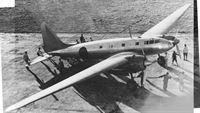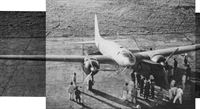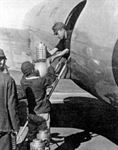
Tachikawa. Различные самолеты
<...>
К более крупным самолетам относятся двухмоторный скоростной разведчик Ki-70 и A26, представлявший собой развитие Ki-77 с увеличенной дальностью полета. Первый из двух прототипов Ki-77 выполнил первый полет 18 ноября 1942 года. В июле 1944 года второй прототип пролетел 16435 км, выполнив несколько кругов по замкнутому маршруту.
<...>
- Описание
Фотографии
-
Aeroplane Monthly 1999-05 / J.Underwood - Tachikawa album /1930s-1940s japanese/
The very streamlined Ki-77 was the result of sponsorship by the Asahi Shimbun newspaper for a nonstop Tokyo - New York flight, but the outbreak of war prevented this. However, the first of two prototypes set an unofficial closed circuit record of 19 circuits totalling 10,212 miles in 57hr 12min at Sinkiang. The second prototype was shot down, but the first survived the war to be taken to the USA, where it was eventually scrapped.
-
Aviation Historian 25 / R.Flude - Berlin or bust /The Axis's wartime air links/ (2)
Ki-77 отличали чистота аэродинамики и крыло очень большого размаха, расчетная дальность полета составляла 18000 км.
Powered by two 1,000hp. Nakajima engines similar to those used in the Zero fighter, the Tachikawa A-26 had a top speed of 273 m.p.h. For maximum range it cruised at 186 m.p.h.
The prototype Ki-77-I made its first flight on November 18, 1942, and in January 1943 it undertook a successful test flight between Tachikawa, near Tokyo, and Fukuoka on Kyushu. -
Aviation Historian 25 / R.Flude - Berlin or bust /The Axis's wartime air links/ (2)
Japanese engineers gather around one of the two Ki-77s before another test flight circa 1943.
The Tachikawa Ki.77-I long-range research machine landing following its record flight in Manchuria in July 1944. -
Aeroplane Monthly 1996-08 / T.Gwynn-Jones - A matter of honour
Tail up, the A-26 is about to lift off from Hsinking (now Changchun) to exceed the distance of a nonstop flight from Tokyo to New York. Had it used its fuel reserves, the A-26 could have exceeded the Great Circle distance by more than 4,000 miles.
-
Aeroplane Monthly 1996-08 / T.Gwynn-Jones - A matter of honour
The crew of the record-breaking A-26 salute their mission commander before take-off. On the left are the team's groundcrew.
-
Aviation Historian 25 / R.Flude - Berlin or bust /The Axis's wartime air links/ (2)
Initial design work on the Ki-77 specified a “sealed oxygen cabin”, unpressurised but sealed to prevent loss of oxygen, so as to minimise the use of oxygen masks for the crew on flights of extremely long duration; in the event, the crew did have to use masks fed from cylinders loaded aboard, as seen here.
-
Aeroplane Monthly 1996-08 / T.Gwynn-Jones - A matter of honour
At wars end the A-26 was among a number of Japanese aircraft chosen for evaluation by the USAAF. Here, with its markings removed, it has been painted black before being shipped to the USA.
-
Aeroplane Monthly 1996-08 / T.Gwynn-Jones - A matter of honour
The two-seat cockpit of the Ki-77, which offered an excellent field of vision. The type’s very-high-aspect-ratio wings were of laminar-flow section with 6° dihedral, and contained fuel tanks taking up some 70 per cent of their internal volume. Although the sophisticated cockpit of the A-26 was fully pressurised, leaks forced the crew to wear oxygen masks. Between the pilot's control wheels may be seen the autopilot; this system also failed during the record flight.
The aircraft’s flight-handling characteristics were reportedly excellent, but only two were ultimately built. -
Aviation Historian 25 / R.Flude - Berlin or bust /The Axis's wartime air links/ (2)
Tachikawa Ki-77/A-26
- Фотографии









